Are you looking for low-growing perennial plants for the front of your garden borders? Or maybe you want to finish your edges with a short but showy bloomer? Whatever your need, we have you covered with a selection of our favorite low-growing perennials.
Although there is no official definition of a low-grower, we have chosen plants that do not grow above 12 inches. Whatever you choose, you can be sure it is perfect as a frontline troop so you can see everything else behind it. And with perennials, you can be sure that they will return year after year with the proper care, requiring less effort from you.
We have chosen low-growing perennials with various shapes, growing habits, colors, and zones. So, let’s get down and dirty with our favorite low-growing plants.
Autumn Crocus
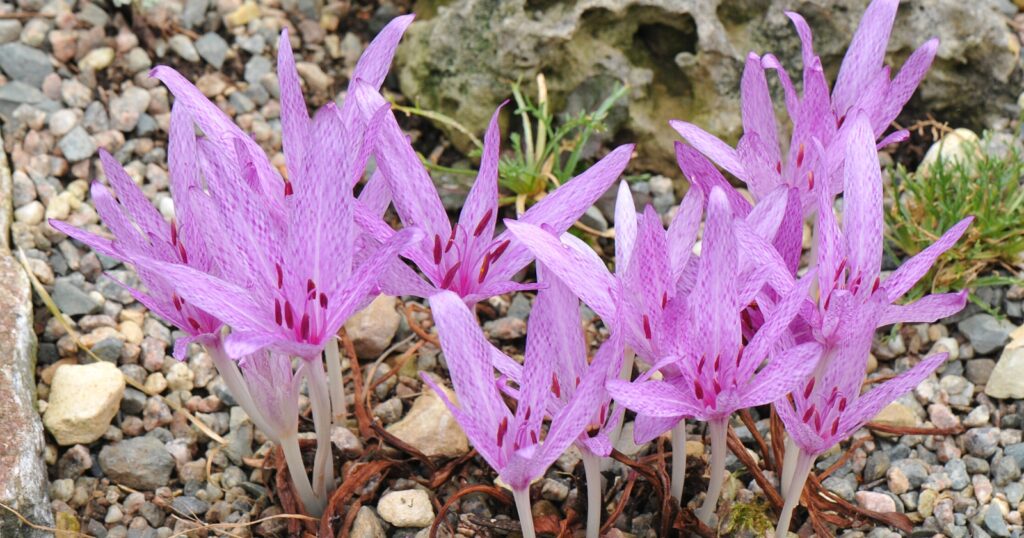
Scientific Name: Colchicum agrippinum
- Height When Mature: Up to 6 inches
- Plant Type: Perennial
- Sun Exposure: Full sun, partial sun
- Soil pH: Acid, Alkaline, Neutral
- Plant Zone: 4 – 9
We have chosen this Autumn Crocus because it is one of the lowest-growing and an award-winning spectacular beauty. The unique purple and pink checkered flowers boom in early fall, providing one last pop of color. The flowers are large, too, measuring 5 inches long, making them a striking option for borders and edging.
This reliable perennial is a favorite with gardeners because it is super easy to grow and avoided by rabbits, deer, and other hungry beasties. This Autumn Crocus likes averagely moist, well-drained soils and full to partial sun to thrive. The whole plant is poisonous, so you must take care when handling the plant.
Barrenwort
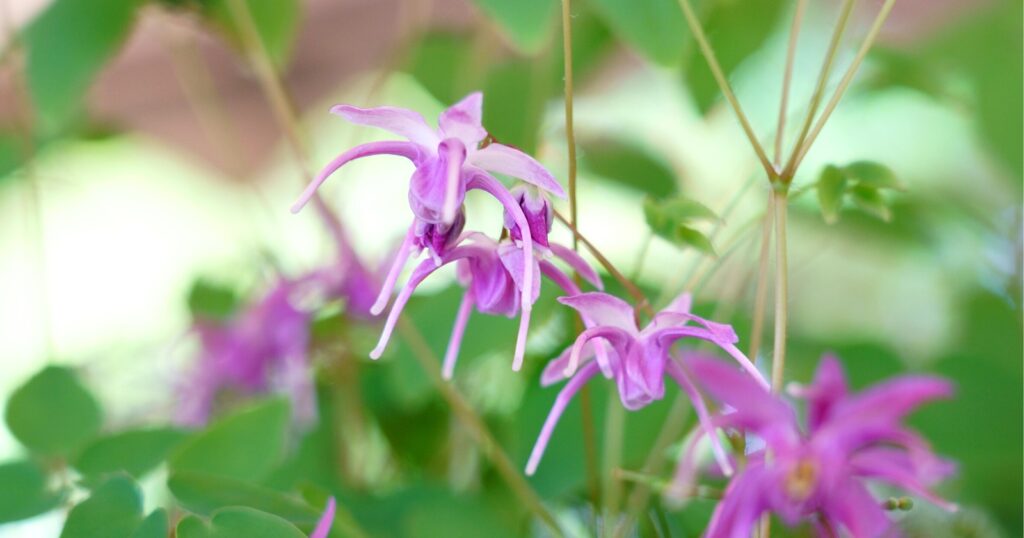
Scientific Name: Epimedium grandiflorum
- Height When Mature: Up to 1 foot
- Plant Type: Perennial
- Sun Exposure: Partial sun, shade
- Soil pH: Acid, Neutral
- Plant Zone: 4 – 8
Barrenwort is an evergreen perennial with beautiful heart-shaped leaves providing edging and borders with constant interest. Perfect if you are seeking permanent coverage for unsightly walls. The leaves are bronzey-purple in color all year round, except for the summer season, when they turn dark green.
In mid-spring, clusters of bright pink flowers with long white shoots hang above the attractive foliage. This romantic-looking perennial is low-maintenance and a shade and dry soil seeker. Making it a popular option to plant under trees and shrubs where most other flowers would struggle to thrive.
Begonia
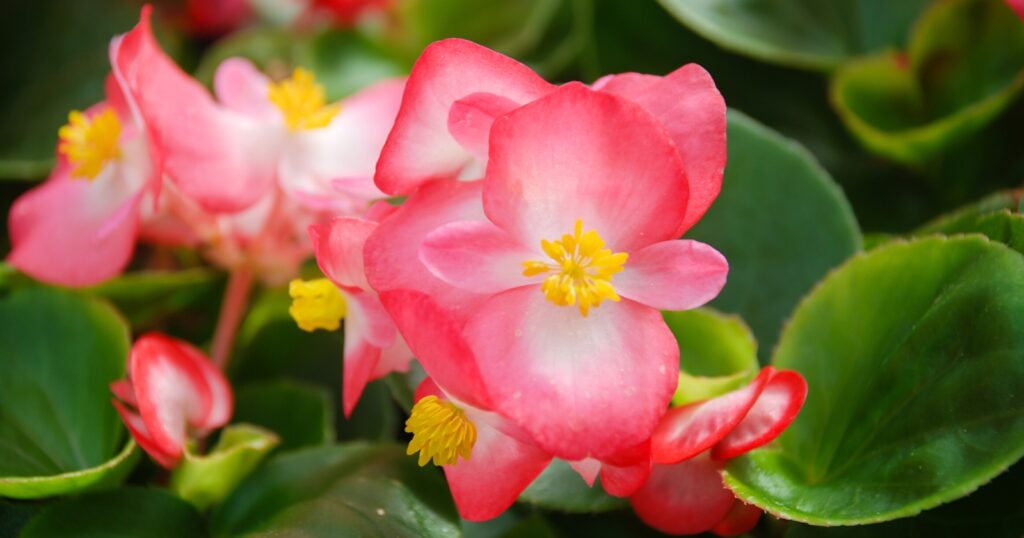
Scientific Name: Begonia
- Height When Mature: Up to 1 foot
- Plant Type: Tender perennial
- Sun Exposure: Partial sun
- Soil pH: Acid, Neutral
- Plant Zone: 7 – 11
There are many species of Begonia, all with varying heights. But many do not grow over 1 foot tall. The Nonstop Series is a low-growing bright, beautiful selection. The Sun Dancer Series produces cascades of showy blooms, making them an excellent choice for planting against a dividing wall.
Begonias come in a wide range of summery colors, making them popular for gardeners worldwide. They prefer partial shade and moist, well-drained soil. They are usually planted as annuals. However, you can dig up the tender tubers before the first frost and store them over winter.
Caucasian Cranesbill
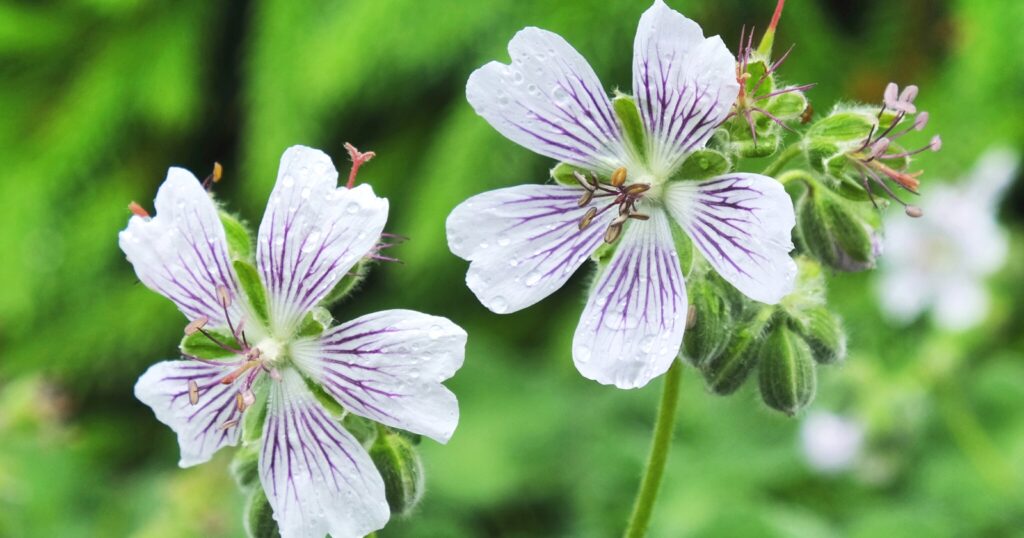
Scientific Name: Geranium renardii
- Height When Mature: Up to 1 foot
- Plant Type: Perennial
- Sun Exposure: Full sun, partial sun
- Soil pH: Acid, Alkaline, Neutral
- Plant Zone: 6 – 8
Also known as the Renard Geranium, it is prized for its attractive semi-evergreen foliage. The velvet sage-green leaves are wrinkled and lobed and turn yellow in the fall, offering textured and long-lasting seasonal interest. From late spring, white blooms arrive, striped with violet veins, lasting several weeks.
This Geranium is easy to grow, care for, and resistant to most pests and diseases. It likes partial sun in dry to medium moisture soils. Once established, it can handle most conditions, even hot and humid ones. It self-seeds freely when happy, allowing it to maintain its spot in your borders and path edges.
Cheddar Pink
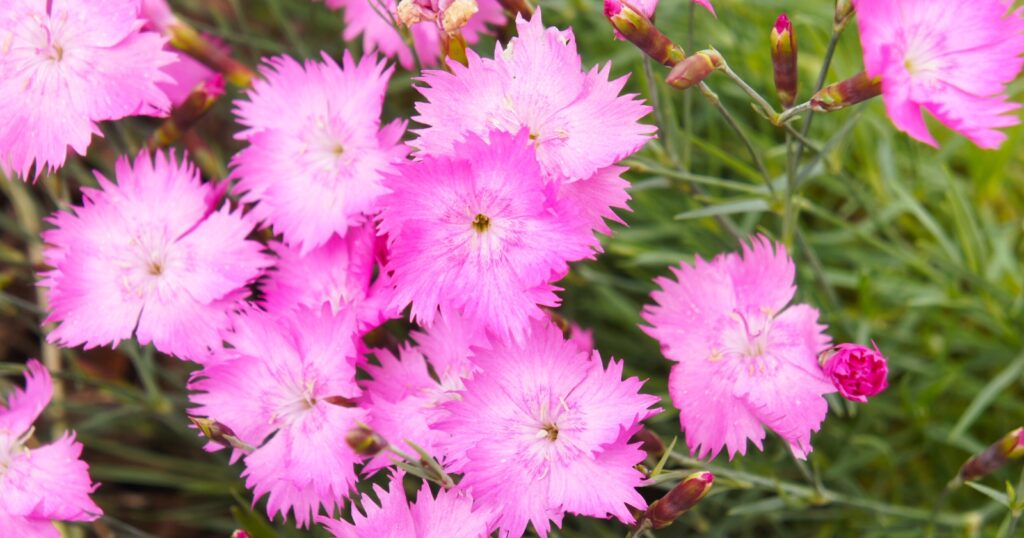
Scientific Name: Dianthus gratianopolitanus
- Height When Mature: Up to 6 inches
- Plant Type: Perennial
- Sun Exposure: Full sun
- Soil pH: Alkaline, Neutral
- Plant Zone: 4 – 8
Cheddar Pink is a low-growing evergreen perennial that provides grass-like gray-green foliage all year round. It produces masses of tiny pink flowers in late spring with frilly petals, adding a beautiful texture to your borders. When deadheaded regularly, Cheddar Pink reblooms in the summer too.
Cheddar Pink is highly fragrant, so be sure to plant it within nostril reach. It also attracts butterflies and other pollinating wildlife, making it a must for wildlife gardens. It is a hardy and tolerant plant. All it asks for is a sunny spot in your garden with well-drained soil.
Creeping Phlox
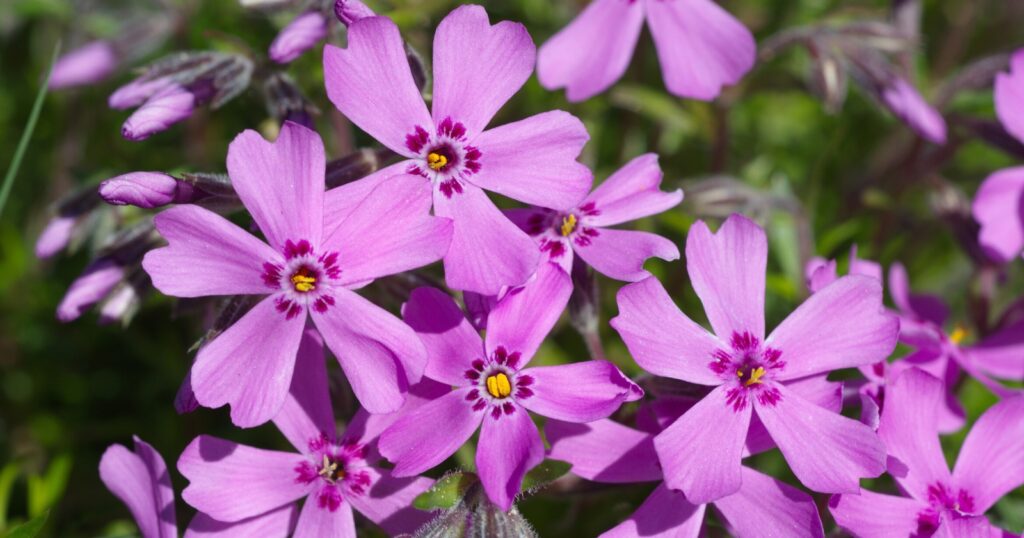
Scientific Name: Phlox subulata
- Height When Mature: Up to 8 inches
- Plant Type: Perennial
- Sun Exposure: Full sun
- Soil pH: Alkaline, Neutral
- Plant Zone: 2 – 9
There are many varieties of Creeping Phlox offering colors like purple, pink, white, red, and multicolored. They grow up to 8 inches tall, hugging the ground and creating a colorful carpet for up to 4 weeks. The needle-like foliage is evergreen, providing an undying green background for later blooming perennials.
The blooms are small and starry, sometimes fragrant. Creeping Phlox is an excellent pick for edgings, border fronts, and slopes. It is reliable, hardy, low-maintenance, and can tolerate sandy soil and salty air. Making it a top choice for coastal areas. Phlox likes humus-rich, medium-moisture soil in the full sun.
Dog’s Tooth Violet
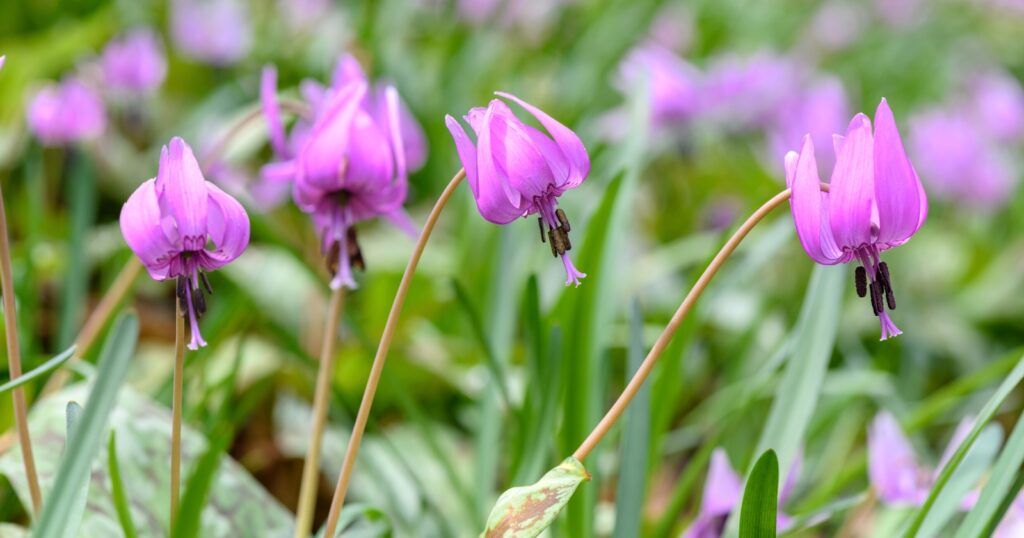
Scientific Name: Erythronium dens-canis
- Height When Mature: Up to 10 inches
- Plant Type: Perennial
- Sun Exposure: Partial sun
- Soil pH: Acid, Alkaline, Neutral
- Plant Zone: 3 – 9
Dog’s Tooth Violet is a striking perennial flower that produces mauve lily-like flowers at the end of each nodding stem. The petals point back to the sky while the bright yellow stamens hang gracefully to the ground. The attractive foliage is bright green and marbled with purple.
Dog’s Tooth Violet is happiest in evenly moist soils with good drainage. It is essential never to let it dry out, even when dormant. In optimum conditions, it will multiply. This flower looks great when planted in large groups on the edge of borders, under trees, or near streams.
Eastern Pasque Flower
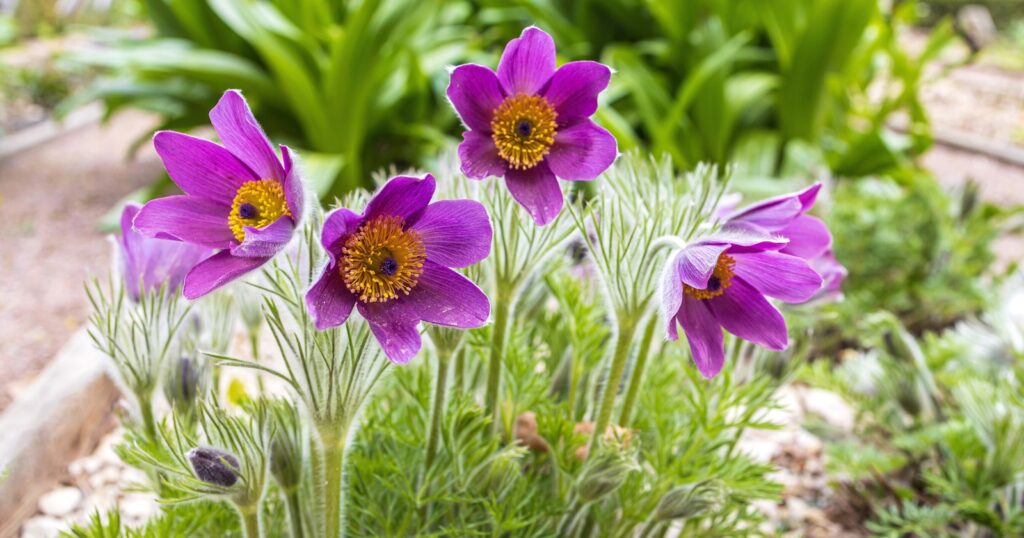
Scientific Name: Pulsatilla patens
- Height When Mature: Up to 1 foot
- Plant Type: Perennial
- Sun Exposure: Full sun
- Soil pH: Acid, Alkaline, Neutral
- Plant Zone: 4 – 7
Sometimes known as the Prairie Crocus, this clump-forming plant produces perennial purple to blue bell-shaped flowers. These cool colors contrast wonderfully with the bright golden dome of stamens. Depending on your location, this plant can bloom from March until June, making it one of the longest-blooming spring flowers.
This perennial plant likes the full sun and gritty, well-drained, dryish soil. When they are happy, they self-seed freely, allowing them to hold their own in perennial borders. They are dormant in the summer, so be sure to mix them with summer-blooming perennials to maximize the color of your landscape.
English Daisy
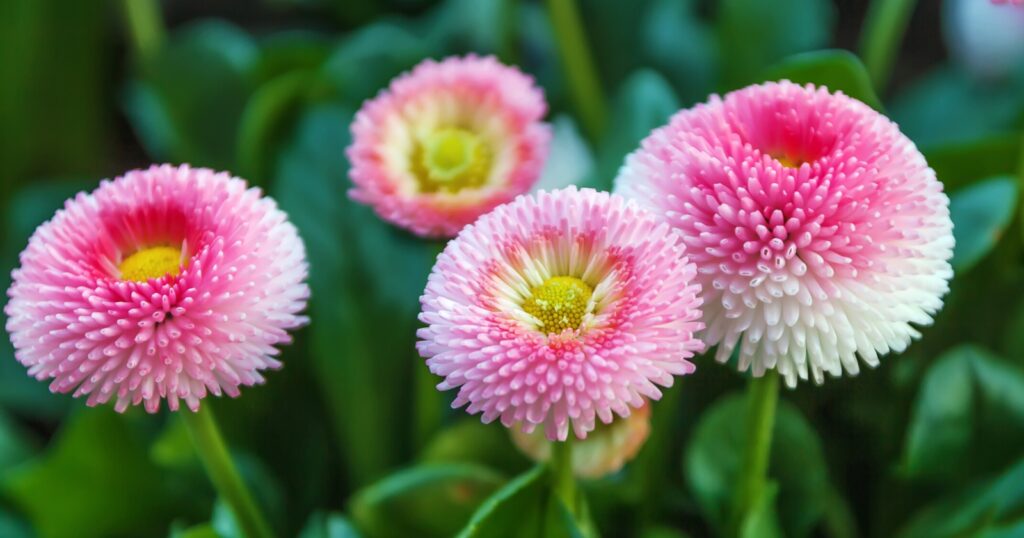
Scientific Name: Bellis perennis
- Height When Mature: Up to 6 inches
- Plant Type: Perennial
- Sun Exposure: Full sun, partial sun
- Soil pH: Acid, Alkaline, Neutral
- Plant Zone: 4 – 8
The English Daisy is an elegant perennial usually grown as a biennial. However, because it self-seeds freely, it maintains its spot in the garden. Allowing it to come back year after year like other perennials. It is a full sun to part shade seeker and needs organically rich, moist soils. English Daisies need constant moisture to remain happy.
Rosettes of spoon-shaped leaves give way to multiple fluffy double flowers. These showy pompom-like flowers come in various shades, including perennial pink, white, and red, with a yellow center. Their short stature makes them ideal for the front of borders and edges, and they look great planted among spring bulbs.
Formosan Lady’s Slipper Orchid
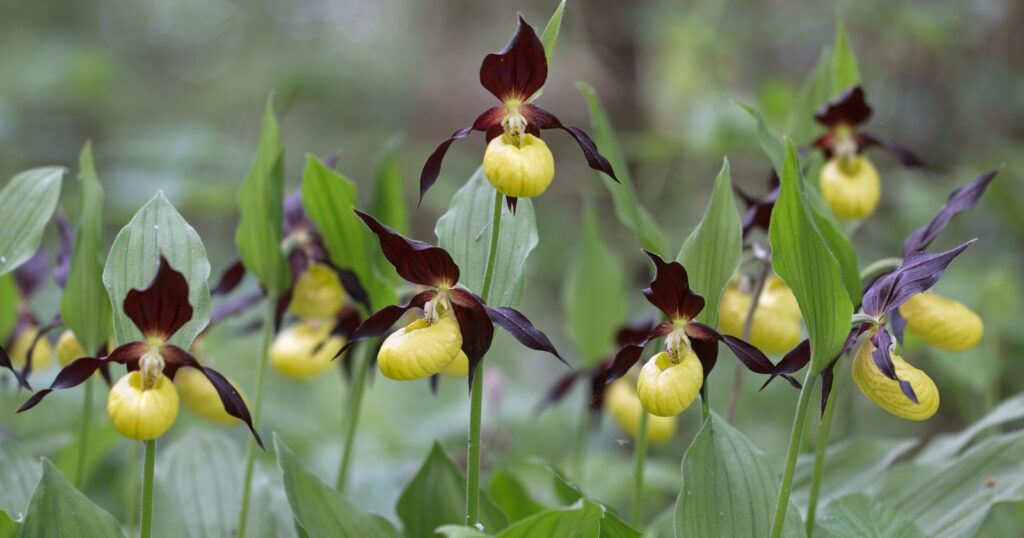
Scientific Name: Cypripedium formosanum
- Height When Mature: Up to 6 inches
- Plant Type: Perennial
- Sun Exposure: Partial sun
- Soil pH: Alkaline, Neutral
- Plant Zone: 6 – 9
This could be your best option if you’re seeking a low-growing Orchid. It is a hardy pick for such a delicate-looking bloom. Slender stems carry one white flower consisting of broad petals and a puffy pouch, spotted with pink. It grows in a clump-like habit, and happy clumps can produce up to 100 stems, meaning 100 flowers!
This charming Orchid needs moist but well-drained soils. It is low-maintenance but has a few specific needs. It requires between 2 to 3 hours of direct sunlight in the morning or late afternoon and intermittent shade for the rest of the day. If you can offer this, it makes a terrific and stunning edging plant for the mid-spring season.
Fringed Bergenia
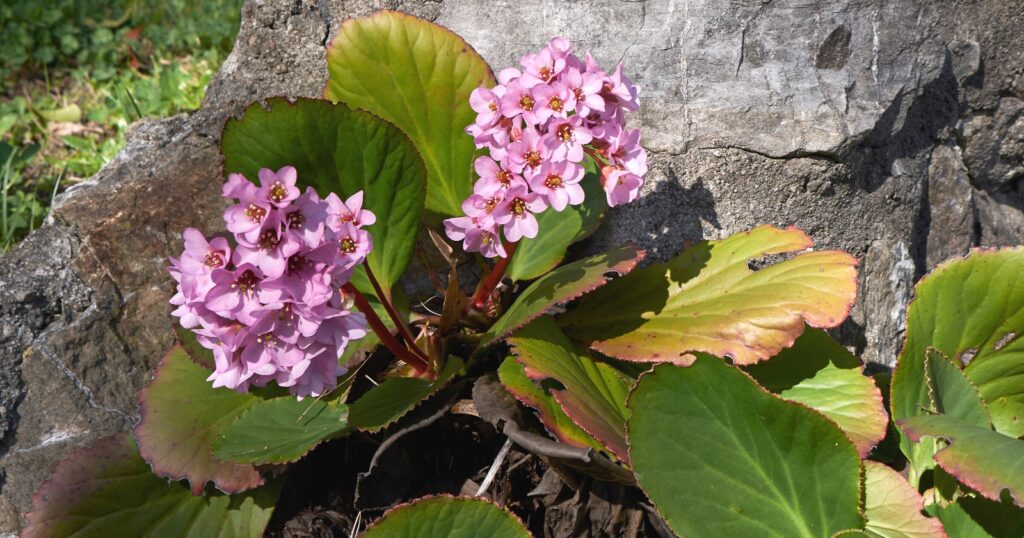
Scientific Name: Bergenia ciliata
- Height When Mature: Up to 10 inches
- Plant Type: Perennial
- Sun Exposure: Full sun, partial sun
- Soil pH: Acid, Alkaline, Neutral
- Plant Zone: 5 – 8
Fringed Bergenia is a slow-growing perennial, but the end result is worth the wait. Rosettes of thick, finely-toothed leaves give way to arching stems. On top of these stems come upward-facing clusters of showy pale to rosy pink flowers that bloom in early spring. They are neat flowers that look great at the front of borders or as edging plants.
Fringed Bergenia grows much lower than other Bergenias. It requires partial sun and moist, well-drained soil to thrive. Never let this plant dry out completely. Once established, it becomes hardier. It also makes a fantastic cut flower too.
Fumewort
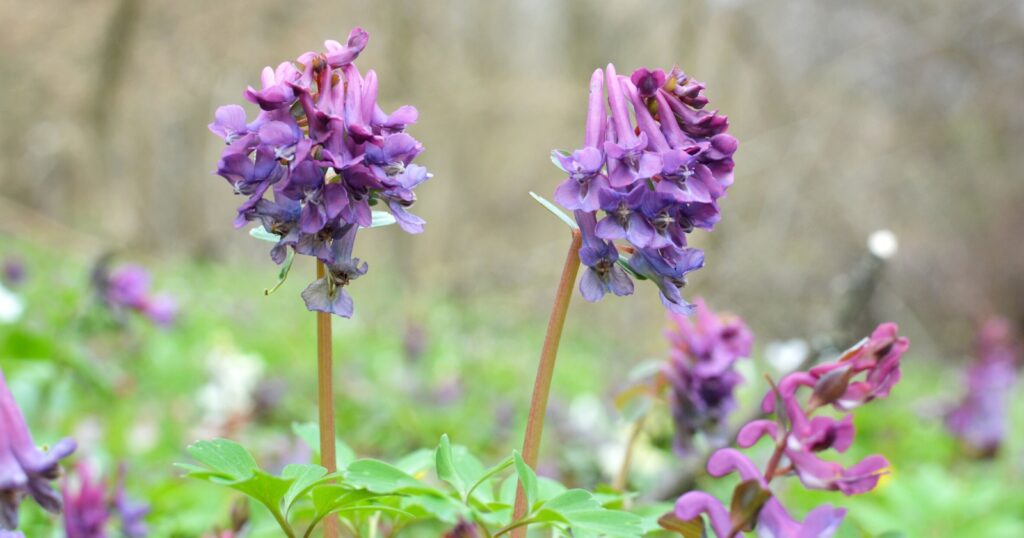
Scientific Name: Corydalis solida
- Height When Mature: Up to 1 foot
- Plant Type: Perennial
- Sun Exposure: Full sun, partial sun
- Soil pH: Acid, Alkaline, Neutral
- Plant Zone: 4 – 8
Corydalis solida is a shorter species of Fumewort, making it the better option for garden borders and edging. Growing on average between 10 and 12 inches, it produces spikes adorned with showy flowers. The tube-shaped flowers are coral pink to red brick in color, with a white tip for a colorful contrast against the blue-green leaves.
They bloom heavily in mid-spring but go dormant in the summer. Fumeworts need full sun to partial shade, with medium to wet soils. It is effortless to grow, virtually disease free, and reliably comes back for many years. The only pest to watch out for is snails.
Glory of the Snow
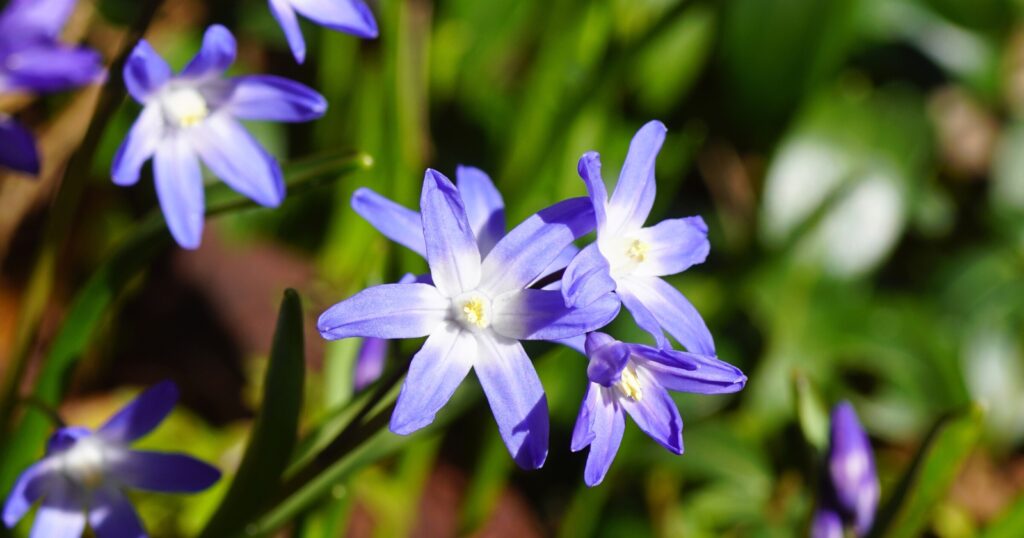
Scientific Name: Chionodoxa
- Height When Mature: Up to 10 inches
- Plant Type: Perennial
- Sun Exposure: Full sun, partial sun
- Soil pH: Acid, Alkaline, Neutral
- Plant Zone: 3 – 9
The name Glory of the Snow is given because it is one of the earliest spring-blooming flowers – one of the first to peep through the snow. Star-shaped flowers are borne atop one-sided racemes. They sport white, blue, lilac, or pink hues, usually with a lighter-colored throat. It provides several weeks of delicate color for the front of borders and edges.
Glory of the Snow typically grows between 6 and 10 inches tall. If you want to increase its numbers the following year, leaving the area undisturbed is essential. Plant them in groups of at least 15 bulbs for the best visual effect. Choose a spot with averagely moist, well-drained soil for best results.
Good Luck Plant
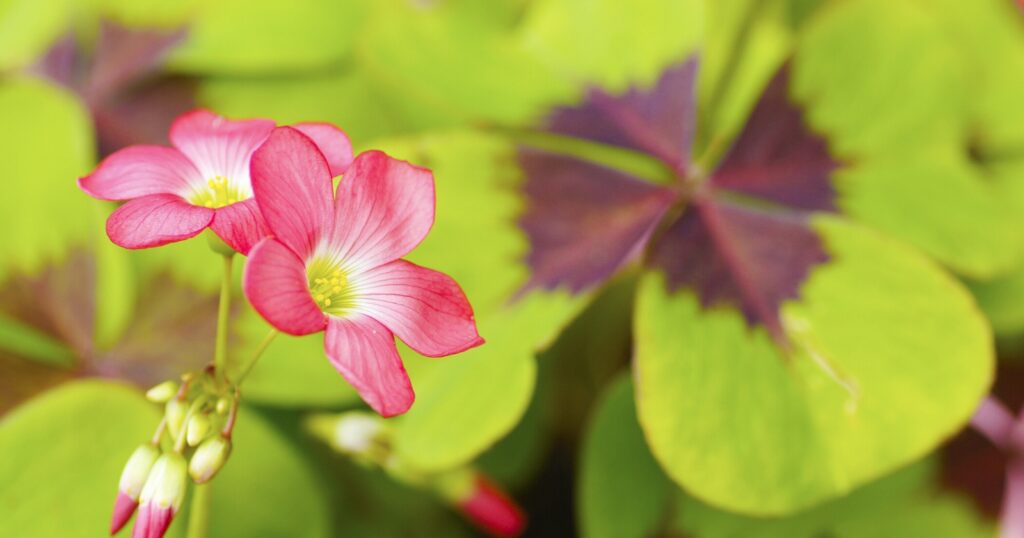
Scientific Name: Oxalis tetraphylla
- Height When Mature: Up to 1 foot
- Plant Type: Perennial
- Sun Exposure: Full sun, partial sun
- Soil pH: Acid, Alkaline, Neutral
- Plant Zone: 7 – 10
Named for its four-leaved clover foliage, the Good Luck Plant is native to Mexico. Each of the four leaves is stained purple at the base, creating a crucifix shape. At night the leaves retract like umbrellas opening up again the following day. This low-growing perennial reaches between 6 to 12 inches tall.
The luscious foliage is covered in bright pink, trumpet-shaped flowers from early summer until the first frost. The Good Luck Plant is easily grown in containers, making it a thoughtful present for gardeners. It likes well drained-soils that are irrigated occasionally.
Grecian Windflower
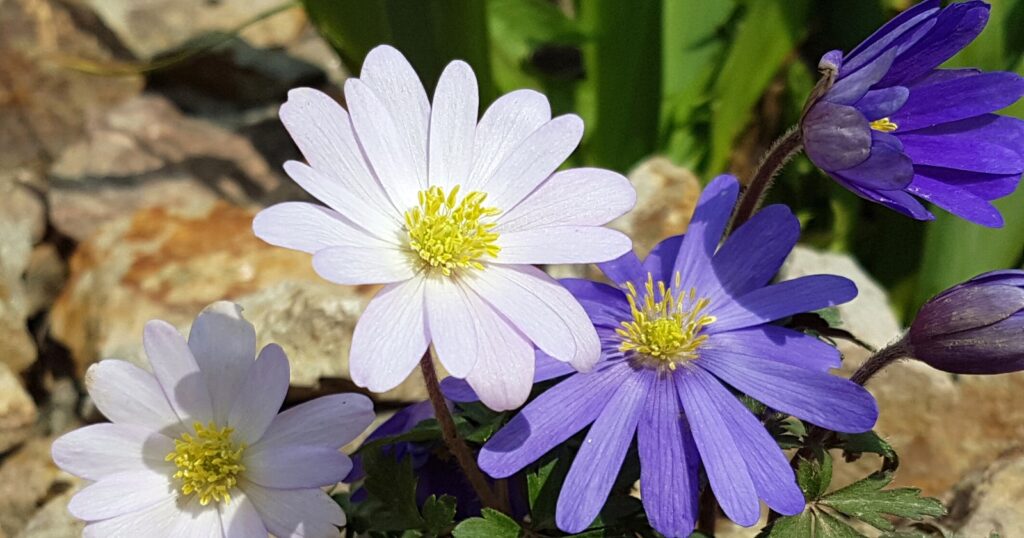
Scientific Name: Anemone blanda
- Height When Mature: Up to 6 inches
- Plant Type: Perennial
- Sun Exposure: Full sun, partial sun
- Soil pH: Acid, Alkaline, Neutral
- Plant Zone: 4 – 8
The Grecian Windflower is another daisy-like bloom that is super popular with gardeners. The blooms sport white, pink, and blue hues, almost covering the green fernlike foliage. This plant goes dormant after flowering, so they are best planted around other flowers to avoid empty border spaces.
Grecian Windflowers like the partial sun but can tolerate full sun if the soil is constantly moist. It spreads quickly in optimum conditions, providing easily achieved color year after year. Plant them in groups of at least 20 to enjoy their spectacular spring show, and look great along pathways or under shady trees.
Homestead Purple
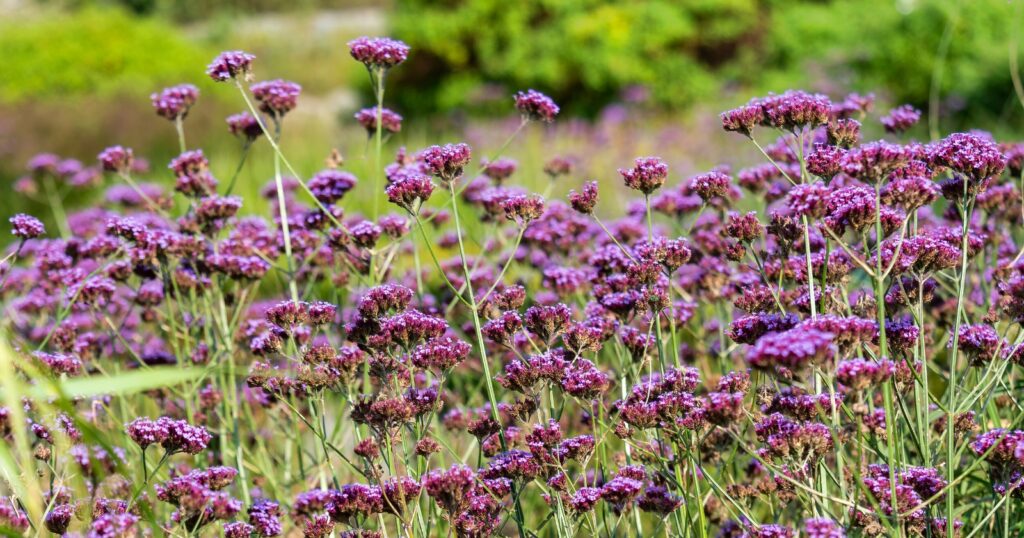
Scientific Name: Verbena canadensis
- Height When Mature: Up to 1 foot
- Plant Type: Tender perennial
- Sun Exposure: Full sun
- Soil pH: Acid, Alkaline, Neutral
- Plant Zone: 6 – 10
Homestead Purple is one of the most popular trailing Verbenas thanks to its long bloom season, easy growth, and low maintenance. It grows in a clump-like habit up to 12 inches tall. From spring to fall, it produces clusters of fragrant bright purple blooms.
Homestead Purple is tolerant of many conditions and does much better in poor soil, making it popular with many gardeners. It thrives in dry to medium, well-drained soils and spreads when happy. In zones 7 to 10, the glossy foliage is evergreen.
Juniper-Leaved Thrift
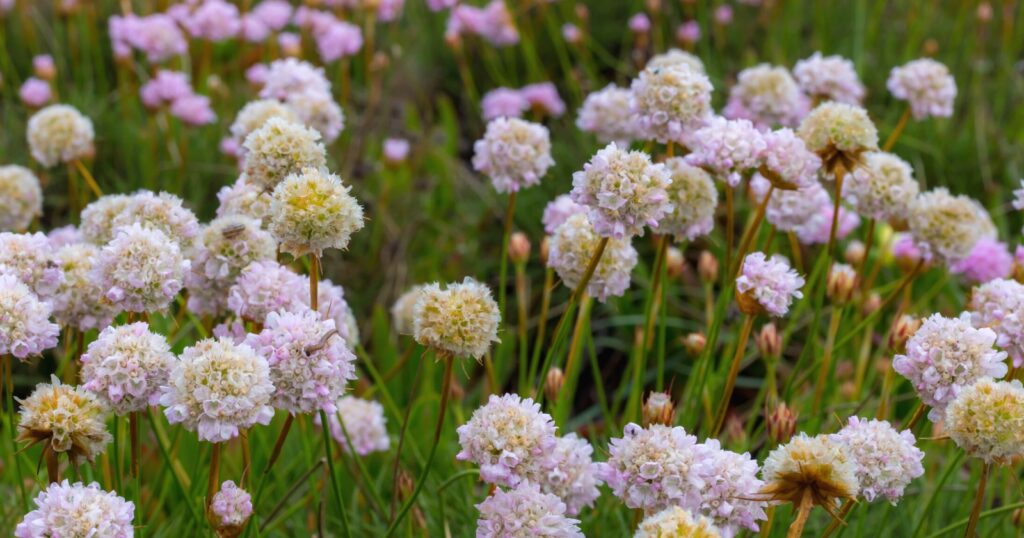
Scientific Name: Armeria juniperifolia
- Height When Mature: Up to 3 inches
- Plant Type: Perennial
- Sun Exposure: Full sun
- Soil pH: Acid, Alkaline, Neutral
- Plant Zone: 5 – 7
Juniper-Leaved Thrift, also known as Spanish Thrift, is a ground-hugging perennial that produces a carpet of light pink flowers in the late spring. These blooms will be the star of the edging or border show for several weeks. The evergreen foliage is needle-like and covers unsightly path edges or low walls all year round if required.
Juniper-Leaved Thrift does best in the full sun with dry, well-drained soils. It is drought-tolerant and must never be overwatered. In cooler night-time climates, it may reflower in the late summer season. It attracts bees and butterflies from afar, and it is deer resistant.
Lily of the Valley
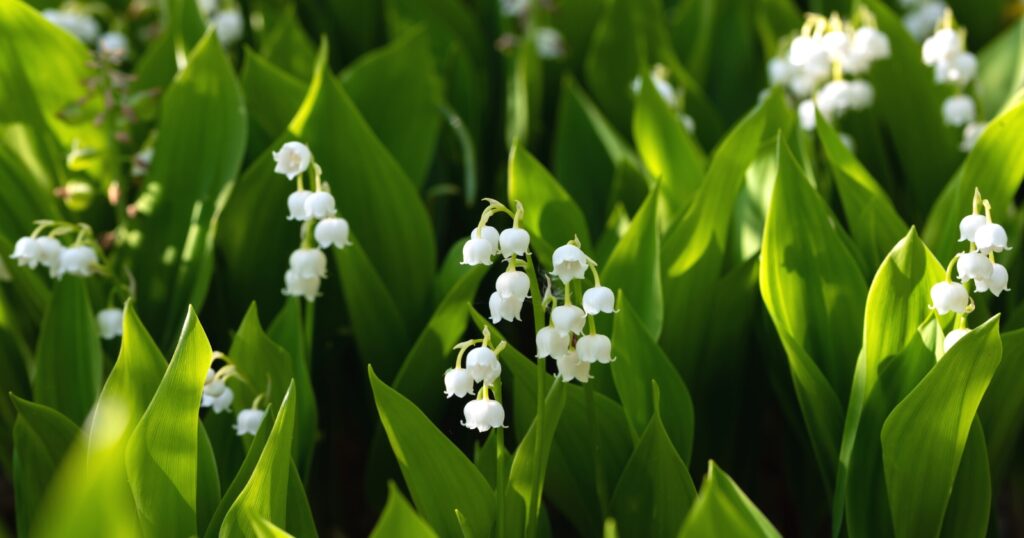
Scientific Name: Convallaria majalis
- Height When Mature: Up to 1 foot
- Plant Type: Perennial
- Sun Exposure: Partial sun, shade
- Soil pH: Acid, Alkaline, Neutral
- Plant Zone: 2 – 7
Lily of the Valley is a long-lived perennial that naturalizes well, maintaining its spot in the garden for years to come. It typically grows between 6 and 12 inches tall. Plus, it is heavily scented, meaning you’ll want to plant it somewhere you can smell it. It blooms in mid-spring for up to 3 weeks.
Lily of the Valley consists of up to 15 nodding bell-shaped flowers per stalk, looking pretty above the bright green foliage. It is virtually pest and disease free, requires little effort from you, and tolerates a wide range of poor soils as long as it is kept moist. It is an excellent option for shady spots and heavy clay gardens.
Lungwort
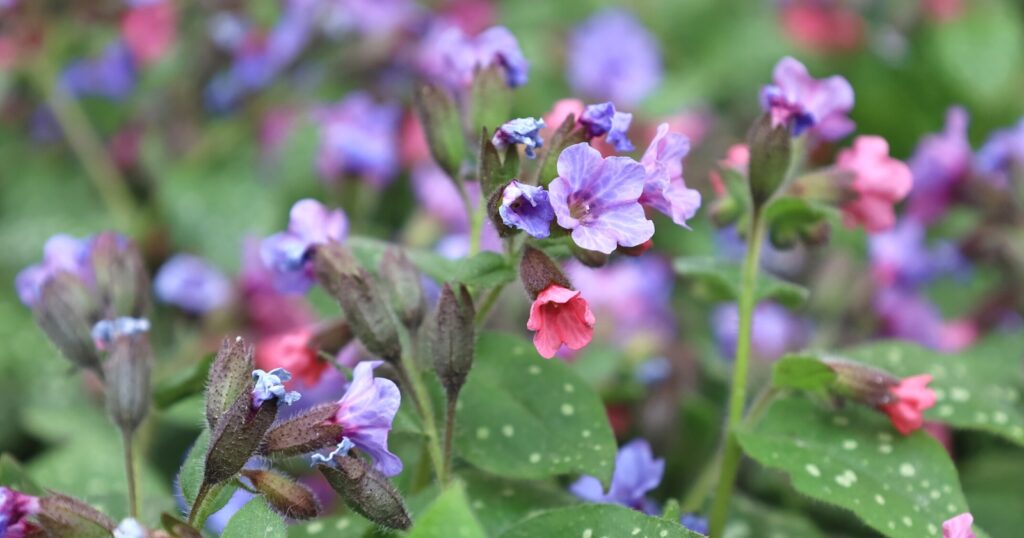
Scientific Name: Pulmonaria
- Height When Mature: Up to 1 foot
- Plant Type: Perennial
- Sun Exposure: Partial sun, shade
- Soil pH: Acid, Alkaline, Neutral
- Plant Zone: 3 – 9
Lungworts are hardy and rewarding, considering how little effort it takes to get them up and running. In the late winter or early spring, clusters of blue, purple, or pink flowers (sometimes a mixture) appear on sturdy stems. The semi-evergreen foliage is just as attractive because of the contrasting green and silver patterned leaves.
Lungwort usually reaches 7 and 12 inches tall and looks great in every garden border. They are shade lovers and can be planted under trees where other flowers fail or along dark pathways. It needs organically rich, medium moisture soils to thrive. Hummingbirds and butterflies adore this plant.
Oyster Plant
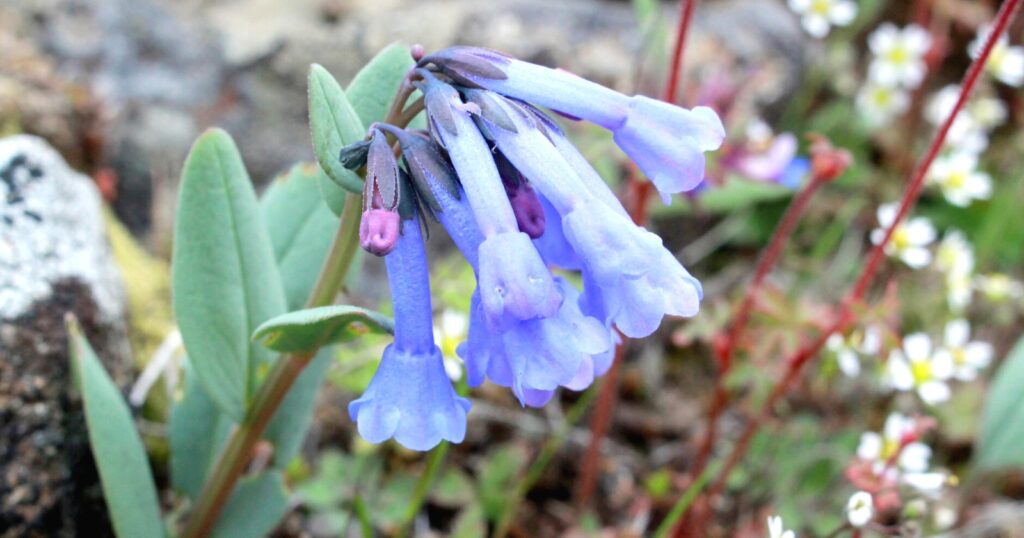
Scientific Name: Mertensia maritima
- Height When Mature: Up to 6 inches
- Plant Type: Perennial
- Sun Exposure: Full sun, partial sun
- Soil pH: Acid, Alkaline, Neutral
- Plant Zone: 3 – 7
Named because the foliage tastes like oysters, the thick, cool green leaves form an attractive rosette base. From there, branched clusters of pink buds open into violet bell-shaped blooms. After several weeks the flowers fade but give way to fruits that ripen in the late summer. This low-reaching spreading perennial offers multi-seasonal interest, making it worthy of a spot in garden borders.
The Oyster Plant is one of the lowest-growing perennials on this list, automatically making it an excellent choice for the edges. It likes coastal areas, rock gardens, and gritty, sharply drained soils to thrive.
Padre’s Shooting Star
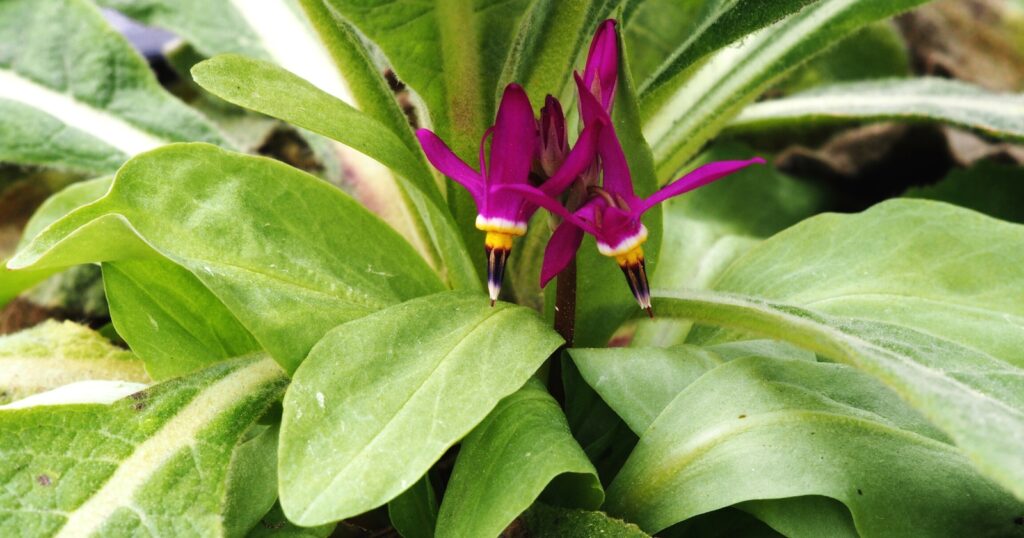
Scientific Name: Dodecatheon clevelandii
- Height When Mature: Up to 1 foot
- Plant Type: Perennial
- Sun Exposure: Full sun, partial sun
- Soil pH: Acid, Neutral
- Plant Zone: 7 – 11
Padre’s Shooting Star is a unique-looking flower worthy of a spot right at the front of your borders. It is another bloom that looks similar to Cyclamens. Instead, the magenta-to-white petals sweep back, resembling a shooting star. There are 2 to 16 flowers per plant, and they bloom from the winter until mid-spring.
Padre’s Shooting Star looks excellent when planted in larger groups for a dramatic impact. They can be grown under trees and shrubs, in a rock garden, or in containers as a focal point. This plant needs organically rich, well-drained soils and prefers a mixture of sun and shade.
Persian Violet
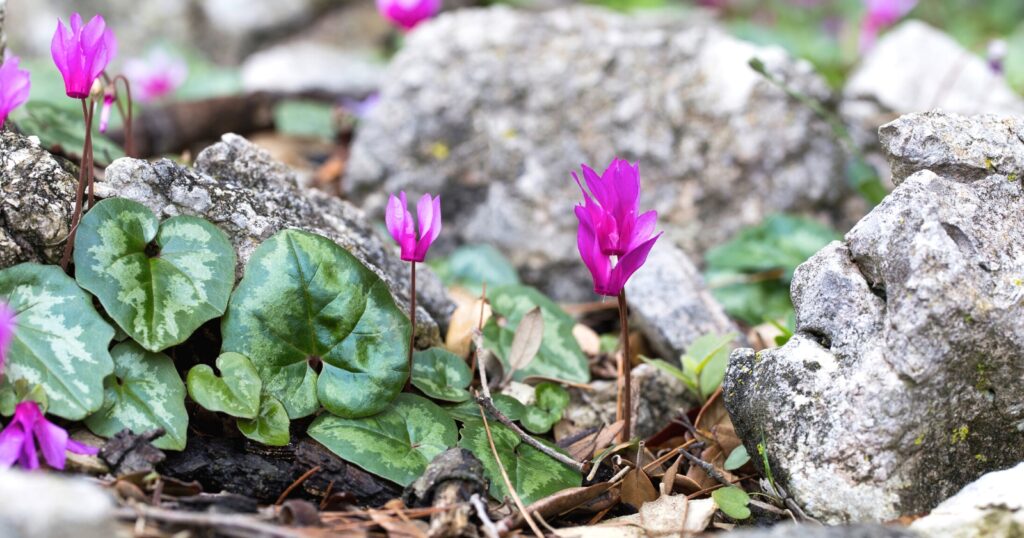
Scientific Name: Cyclamen coum
- Height When Mature: Up to 6 inches
- Plant Type: Perennial
- Sun Exposure: Partial sun
- Soil pH: Acid, Alkaline, Neutral
- Plant Zone: 4 – 8
The Persian Violet is a much-welcomed sight for gardeners because it indicates the start of spring and warmer days ahead. The blooms are pea-like and sit atop thick brown stems, and they sport many colors, including pink, purple, blue, and white. The leaves are just as attractive, thanks to their romantic heart shape and silver spot patterns.
This Cyclamen species is one of the hardiest and can withstand freezing climates. It needs moist but well-drained fertile soils to thrive. They are easygoing picks for garden borders and look great around trees and shrubs, along the edge of paths, and in containers. Just be mindful that they are toxic to dogs, cats, and horses.
Pussy Toes
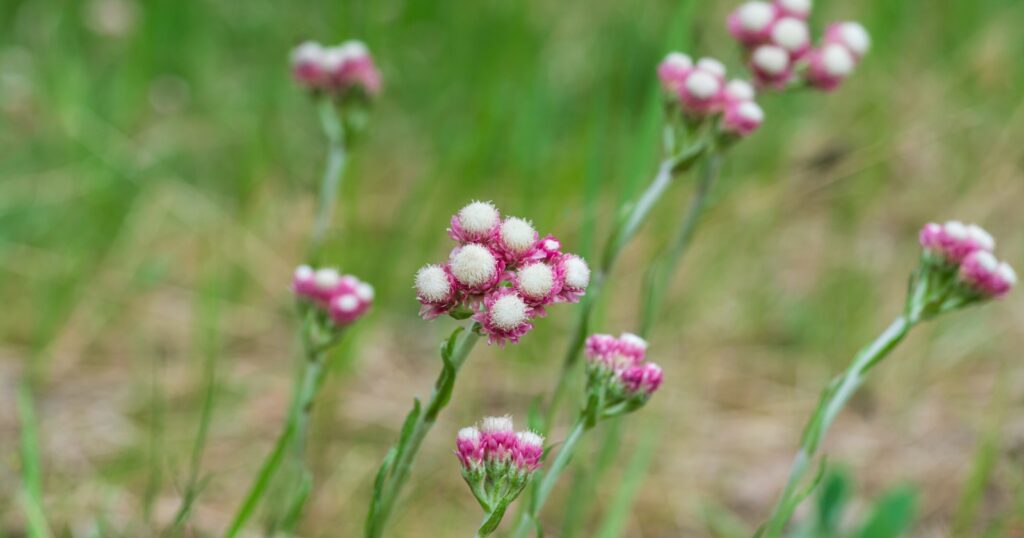
Scientific Name: Antennaria dioica
- Height When Mature: Up to 3 inches
- Plant Type: Perennial
- Sun Exposure: Full sun
- Soil pH: Acid, Alkaline, Neutral
- Plant Zone: 3 – 8
Pussy Toes is one of the lowest-growing perennials on this list, making them a must for garden borders and edges. In the late spring, tall stems rise, boasting soft, fuzzy pink and white flowerheads. And these flowerheads resemble the toes of a pussycat. The foliage is delicate and grass-like.
Pussy Toes perform best in the full sun, like sandy, dry to medium moisture, well-drained soils. This plant does well in dry and hot locations, making it a versatile option. It is also virtually pest and disease free, making it low maintenance.
Rain Lily
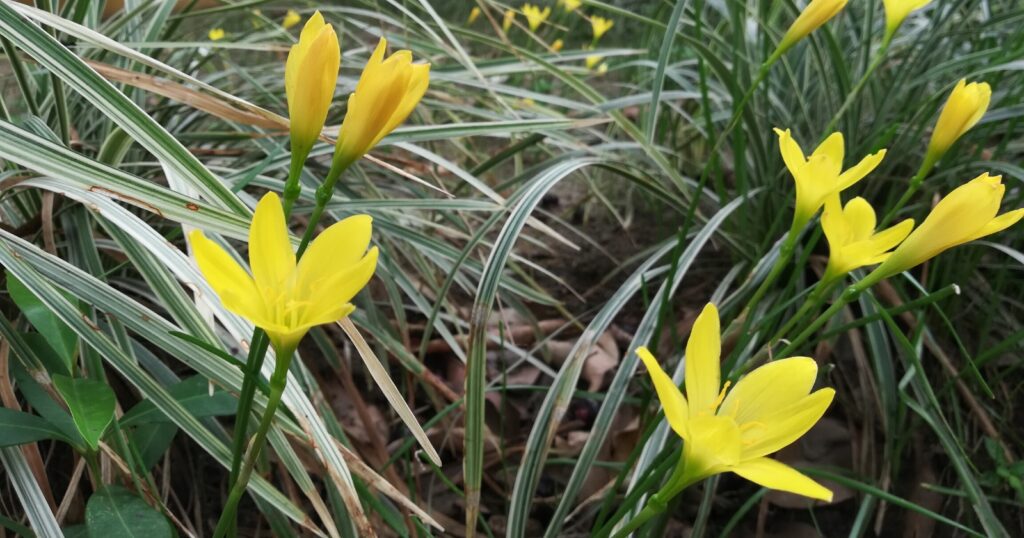
Scientific Name: Zephyranthes citrina
- Height When Mature: Up to 6 inches
- Plant Type: Perennial
- Sun Exposure: Full sun
- Soil pH: Acid, Alkaline, Neutral
- Plant Zone: 7 – 10
The Rain Lily looks like a crocus which is why it is sometimes referred to as the Summer Crocus. It grows between 4 and 6 inches and looks great when planted in large groups or drifts. The bright yellow flowers are large and bloom for weeks in the late summer.
The Rain Lily is native to Argentina, Brazil, and the surrounding areas. It needs full sun to thrive, along with fertile and moist, well-drained soil. In cooler regions outside its hardy zone, the bulbs must be dug up and protected over the winter if you want to keep them for the following year.
Rock Soapwort
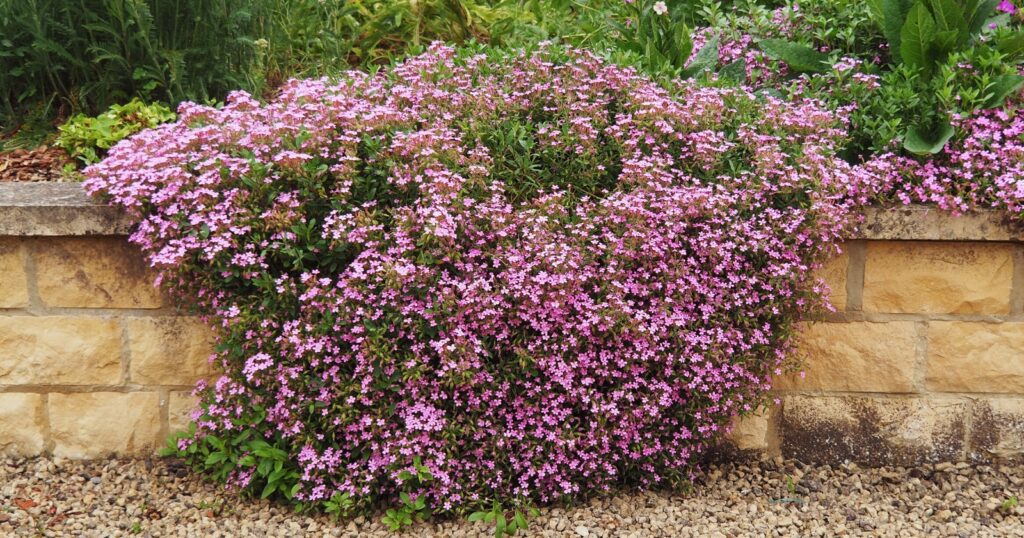
Scientific Name: Saponaria ocymoides
- Height When Mature: Up to 9 inches
- Plant Type: Perennial
- Sun Exposure: Full sun
- Soil pH: Alkaline, Neutral
- Plant Zone: 2 – 9
Rock Soapwort is a semi-evergreen, slightly woody ground-hugging perennial. The foliage consists of small, dark-green leaves that spread over rocks and walls. In the early summer, it produces masses of tiny pink flowers that cling onto the end of the branches, covering the foliage entirely.
Rock Soapwort likes the full sun but does not do well in hot and humid conditions. Instead, it prefers cool and breezy climates. It is easy to grow and maintain and likes dry to medium moisture, well-drained soils. It grows between 6 and 9 inches tall, but be sure to cut it back heavily after flowering to maintain its shape and stimulate reblooming.
Sage
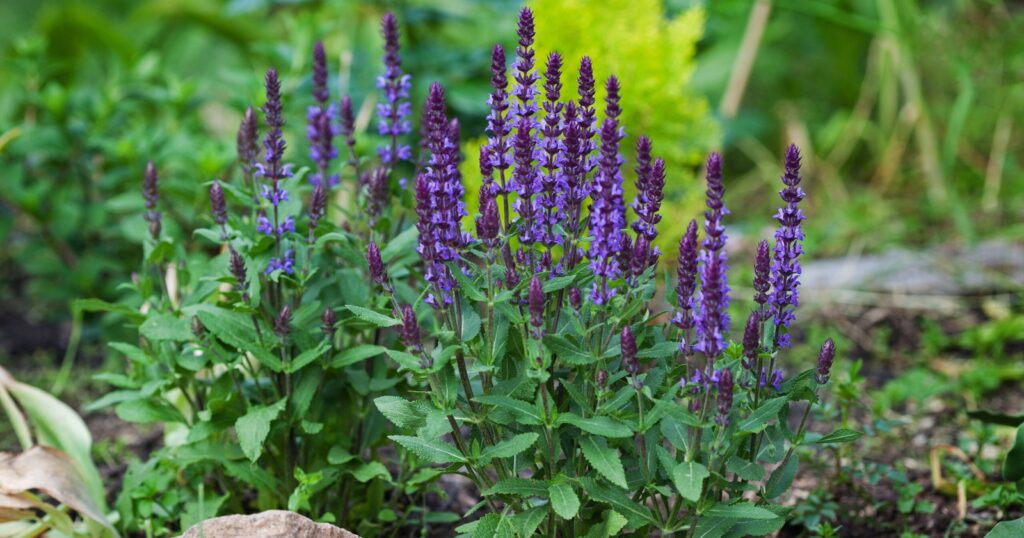
Scientific Name: Salvia nemorosa
- Height When Mature: Up to 1 foot
- Plant Type: Perennial
- Sun Exposure: Full sun
- Soil pH: Acid, Alkaline, Neutral
- Plant Zone: 3 – 9
Some Salvia species reach up to 4 feet tall, but Salvia nemorosa is one of the lowest-growing. The shortest varieties that look great as edging or at the front of borders include Blue Marvel, Bumbleberry, New Dimension Blue, New Dimension Rose, and Rose Marvel. These varieties come in various warm blue, purple, and pink hues.
Sage is a staple in many gardens because of its qualities. It is straightforward to grow, versatile, and trouble-free. The foliage is aromatic, and bees and butterflies love it too. Salvia prefers the full sun with gravelly, dry to medium soils and good drainage.
Sea Thrift
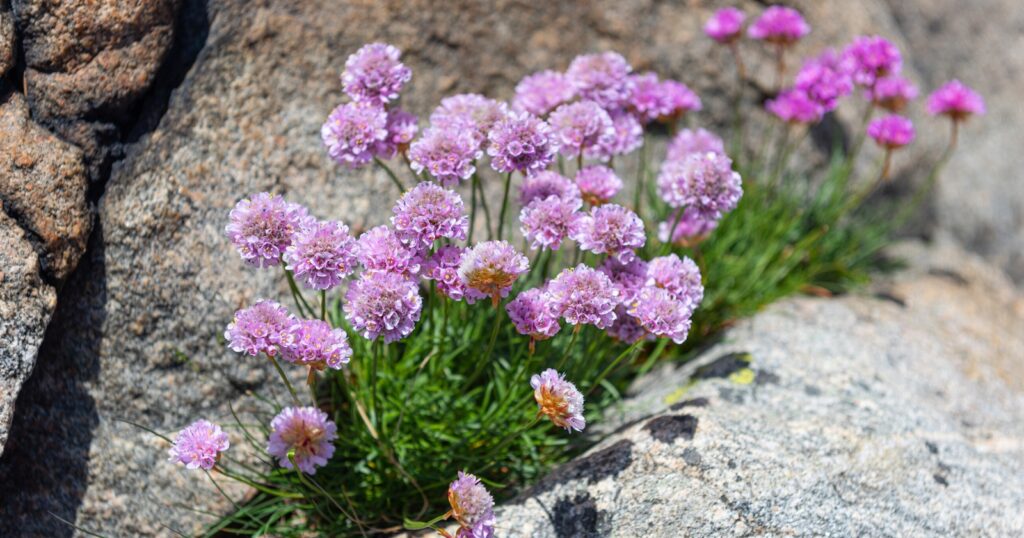
Scientific Name: Armeria maritima
- Height When Mature: Up to 1 foot
- Plant Type: Perennial
- Sun Exposure: Full sun
- Soil pH: Acid, Alkaline, Neutral
- Plant Zone: 3 – 9
Sea Thrift is a compact perennial that produces spherical clusters of lilac, pink, or white flowers. These clusters sit on top of slender stems that grow between 3 and 12 inches tall. Sea Thrift blooms in the early spring and lasts for several weeks. The grass-like foliage mounds are evergreen, providing color and texture all year.
Most varieties like to be placed in the full sun, but few prefer dappled shade, so be sure to research what your chosen one needs. Sea Thrift likes infertile, dry, and well-drained soils. It is easygoing, but it only needs to be divided every few years when the center becomes bare.
Seaside Daisy
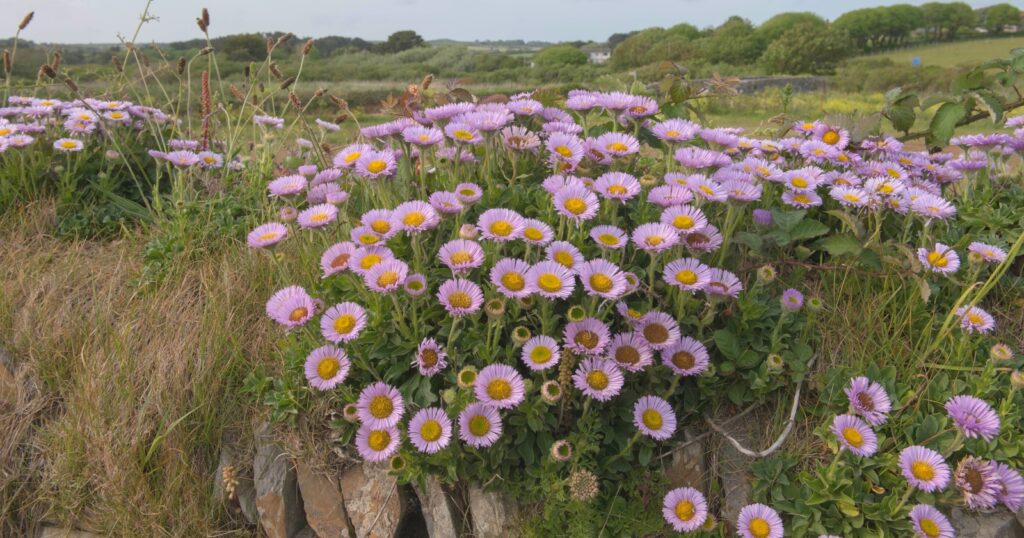
Scientific Name: Erigeron glaucus
- Plant Type: Perennial
- Sun Exposure: Full sun, partial sun
- Height When Mature: Up to 1 foot
- Soil pH: Acid, Alkaline, Neutral
- Plant Zone: 5 – 8
The Seaside Daisy boasts large lavender-pink blooms with a fluffy yellow center. The colorful shows start in mid-spring and last for several months. The dark green spoon-shaped foliage is nowhere to be seen during this time. In mild climates, it is evergreen. It is native to coastal regions of California and surrounding areas.
The Seaside Daisy likes full to partial sun and dry to medium moisture, well-drained soils to thrive. It looks great as an edging plant or in the front of borders, typically reaching 6 to 12 inches in height. Be mindful that it is toxic to dogs, cats, and horses.
Silver Shamrock
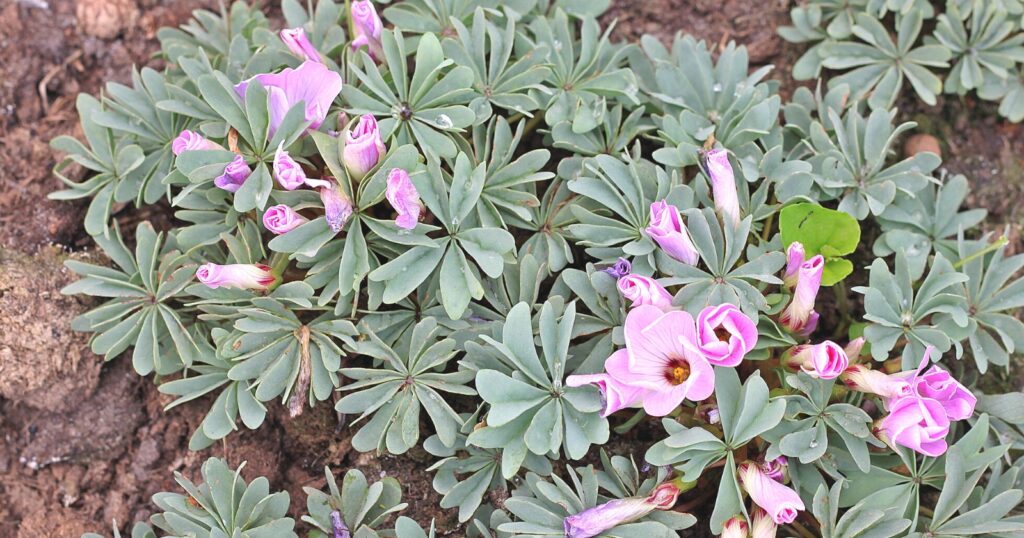
Scientific Name: Oxalis adenophylla
- Height When Mature: Up to 4 inches
- Plant Type: Perennial
- Sun Exposure: Full sun, partial sun
- Soil pH: Acid, Alkaline, Neutral
- Plant Zone: 4 – 9
Silver Shamrock is a delightfully clump-forming plant with silvery green clover-shaped leaves. The delicate lilac-to-white flowers are veined with deep purple leading to a deep purple throat and contrasting yellow stamens. Measuring 1 inch across, they are the main star of the shamrock show from the end of spring.
Silver Shamrock grows up to 4 inches tall, making this one of the lowest-growing perennials on this list. It likes full sun to part shade in humus-rich, well-drained soil. When happy, it naturalizes easily. It looks fantastic at the front of borders and edges, as well as rock gardens.
Spotted Dead Nettle
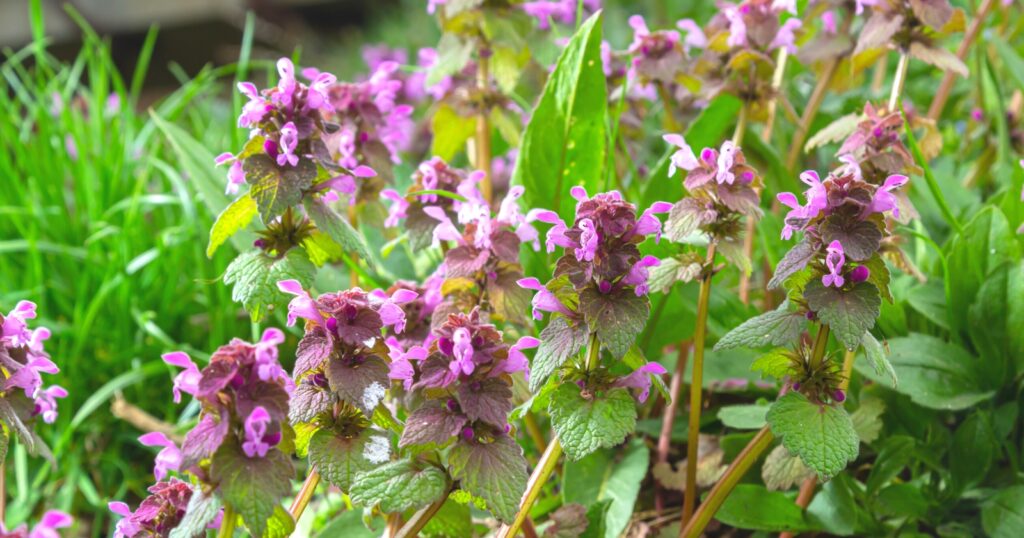
Scientific Name: Lamium maculatum
- Height When Mature: Up to 8 inches
- Plant Type: Perennial
- Sun Exposure: Partial sun, shade
- Soil pH: Acid, Alkaline, Neutral
- Plant Zone: 3 – 8
Spotted Dead Nettle might not sound like a handsome descriptive, but it is an attractive perennial popular for shady gardens. It fills areas quickly and is a long bloomer from mid-spring to fall. The blooms are magenta, pink or white with hoods, and the foliage is sometimes variegated for an extra colorful punch.
Spotted Dead Nettle is trouble-free, and deers and rabbits avoid it. Plus, it is drought-tolerant. All it asks is humus-rich, medium moisture, well-drained soil, and a shady garden spot. It will take over if left to its own devices, so be sure to control it.
Spring Starflower
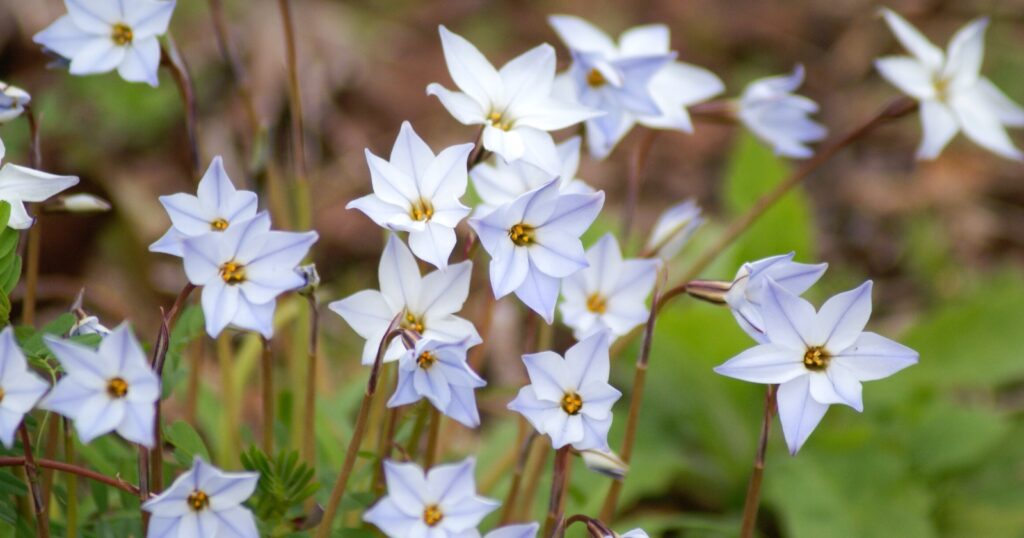
Scientific Name: Ipheion
- Height When Mature: Up to 6 inches
- Plant Type: Perennial
- Sun Exposure: Full sun, partial sun
- Soil pH: Acid, Alkaline, Neutral
- Plant Zone: 5 – 9
The Spring Starflower is a tiny spring bulb perennial with delicate star-shaped flowers. The flowers are usually white or light violet, but brighter violet and pink cultivars exist. They rise from small mounds of grass-like leaves and emit a sweet violet scent. They typically grow between 3 and 6 inches so be sure to plant them where they can be admired.
Ipheion naturalizes well and comes back year after year without much effort from gardeners. It likes averagely moist, well-drained soils. Spring Starflowers are one of the easiest spring bulbs to grow.
Squirrel Corn
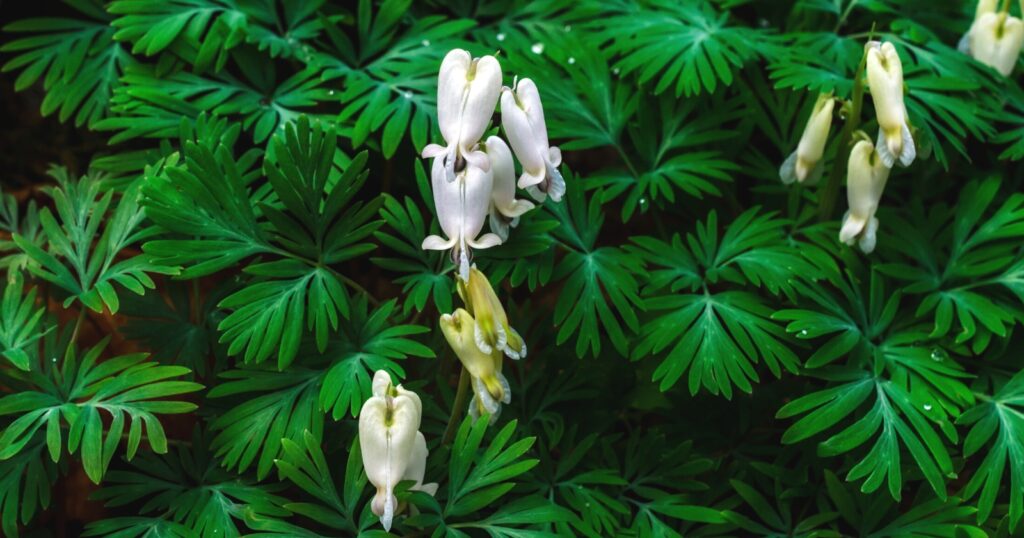
Scientific Name: Dicentra canadensis
- Height When Mature: Up to 1 foot
- Plant Type: Perennial
- Sun Exposure: Partial sun, shade
- Soil pH: Acid, Neutral
- Plant Zone: 3 – 7
Squirrel Corn is part of the Bleeding Heart family, Dicentra. But this variety is called Squirrel Corn because mice and chipmunks can’t resist it. It is also one of the lowest-growing Dicentra, making it an excellent pick for borders and edging. It likes part shade in moist and humus-rich soil.
Squirrel Corn grows in a clump-like habit reaching 8 to 12 inches on average. The lacy blue leaves give way to arching stems in mid-spring, producing 4 to 8 white heart-shaped flowers. The porcelain-like jewels are fragrant, so plant them where you can appreciate their scent.
Stiff Twinspur
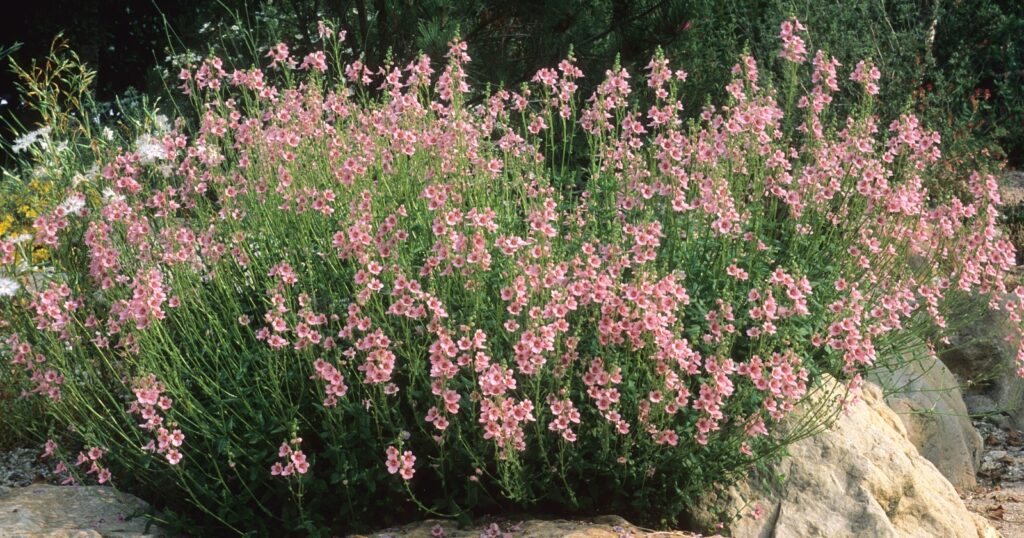
Scientific Name: Diascia rigescens
- Height When Mature: Up to 10 inches
- Plant Type: Perennial
- Sun Exposure: Full sun
- Soil pH: Acid, Alkaline, Neutral
- Plant Zone: 7 – 9
Stiff Twinspur is a cheery plant that grows between 8 and 10 inches tall. The bright pink blooms grow on stiff stems and last from early summer until fall. The heart-shaped foliage is semi-evergreen. It grows in a sprawling habit making it ideal for edging, at the front of borders, and over walls.
Stiff Twinspur is native to South Africa, and it likes a sunny spot in the garden. The soil must be fertile and have medium moisture with good drainage to thrive. It is a low-maintenance plant that is easy to grow and almost trouble-free. Watch out for slugs and snails.
Sweet Violet
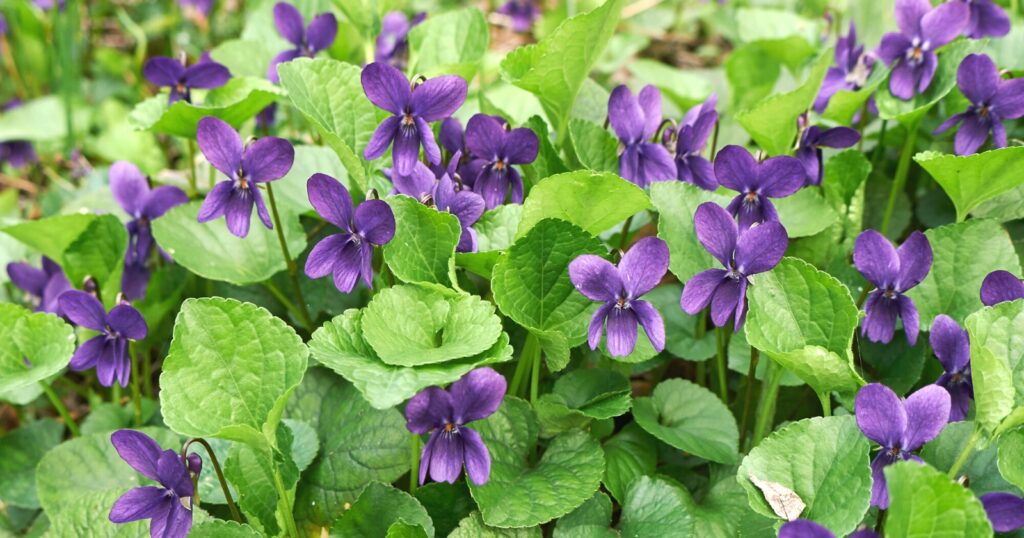
Scientific Name: Viola odorata
- Height When Mature: Up to 10 inches
- Plant Type: Perennial
- Sun Exposure: Full sun, partial sun
- Soil pH: Acid, Alkaline, Neutral
- Plant Zone: 4 – 9
Sometimes known as the Sweet Pansy, it is sweetly scented. The Sweet Violet blooms in the winter and into early spring, providing you with the first burst of garden color. The dark purple to blue flowers have yellow throats, sometimes with freckled or streaked patterning. Sweet Violets can be eaten fresh or candied, making them a baker’s staple in the garden.
This flower prefers shade, making it a great way to inject color into dull areas. Sweet Violets also like moist and fertile, well-drained soils. They are generally easygoing but have several pests and diseases to contend with. Including slugs, violet gull midge, and powdery mildews.
Tolmie Star-Tulip
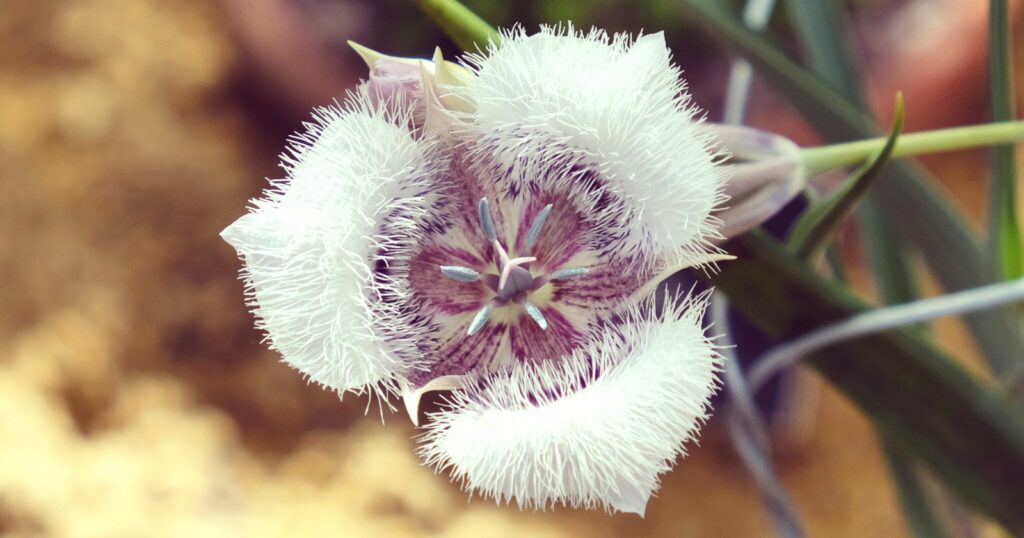
Scientific Name: Calochortus tolmiei
- Height When Mature: Up to 1 foot
- Plant Type: Perennial
- Sun Exposure: Full sun, partial sun
- Soil pH: Acid, Alkaline, Neutral
- Plant Zone: 6 – 9
Sometimes called the Hairy Star Tulip, this is one of the most unique-looking blooms on this list. The flowers are bell-shaped, and the petals are white to lavender, completely covered in fine, silky hair. They appear mid-spring and last several weeks, providing butterflies with a nectar feast.
Tolmie Star-Tulip is native to the west coast of the USA and can tolerate a wide range of conditions, including full sun to mostly shade. It prefers sandy soils with good drainage. It requires very little water and, once established, no water at all.
Trailing Ice Plant
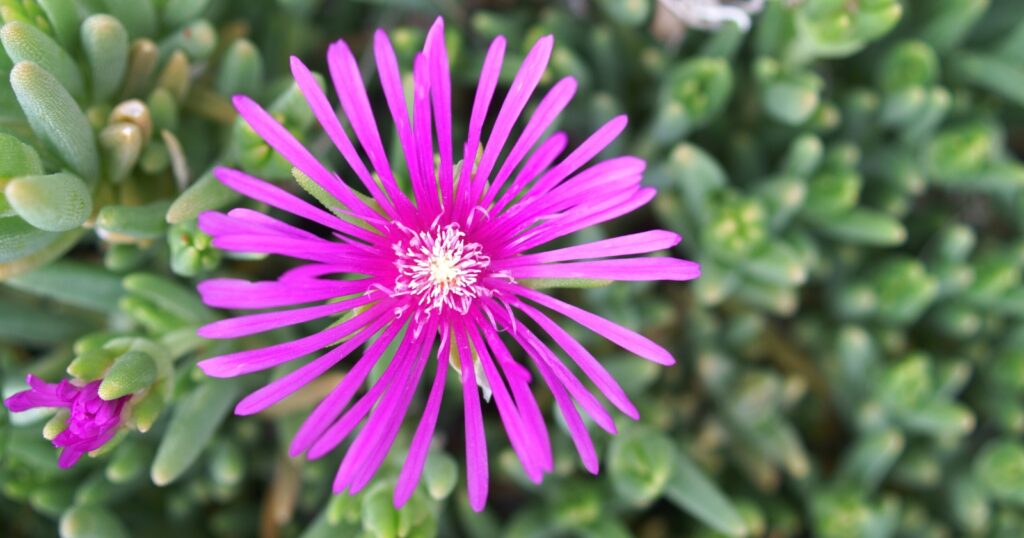
Scientific Name: Lampranthus spectabilis
- Height When Mature: Up to 1 foot
- Plant Type: Perennial
- Sun Exposure: Full sun
- Soil pH: Acid, Alkaline, Neutral
- Plant Zone: 8 – 10
The Trailing Ice Plant is an evergreen perennial succulent that grows in a sprawling habit. The daisy-like bright pink, purple, or white blooms cover the entire foliage, providing a sea of summery color. In warmer climates, it blooms from winter to spring, and in cooler regions, from summer to fall.
The Trailing Ice Plant grows between 6 and 12 inches tall and spreads quickly. It is heat, drought, and salty air tolerant, making it a hardy perennial for coastal areas. Butterflies also love this plant.
Treasure Flower
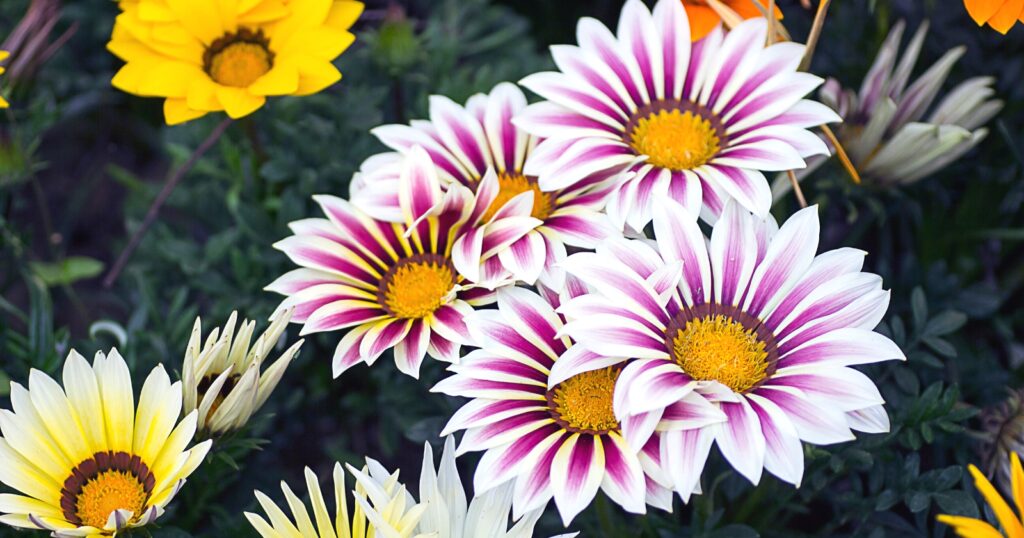
Scientific Name: Gazania
- Height When Mature: Up to 10 inches
- Plant Type: Tender perennial
- Sun Exposure: Full sun
- Soil pH: Acid, Alkaline, Neutral
- Plant Zone: 8 – 10
The Treasure Flower is an exceptional tender perennial. Despite only reaching 8 to 10 inches in height, the blooms measure 5 inches wide. Making them a striking pick for the front of borders. The daisy-like flowers are light cream to yellow, each with a dark pink stripe.
Gazanias bloom heavily in the late spring for several weeks and throughout the year in warmer regions. They like the vs but can grow in most soil types. They don’t require much water, and letting the soil dry out in between watering is essential.
Wrap Up
As you have seen, low-growing flowers can be just as showy and ornamental as their taller perennial cousins. Whether you have chosen a dainty Dog’s Tooth Violet or a unique-looking Tolmie Star-Tulip, you are sure to enjoy their shorter qualities. We hope you have found the perfect perennial for your garden borders and edges.

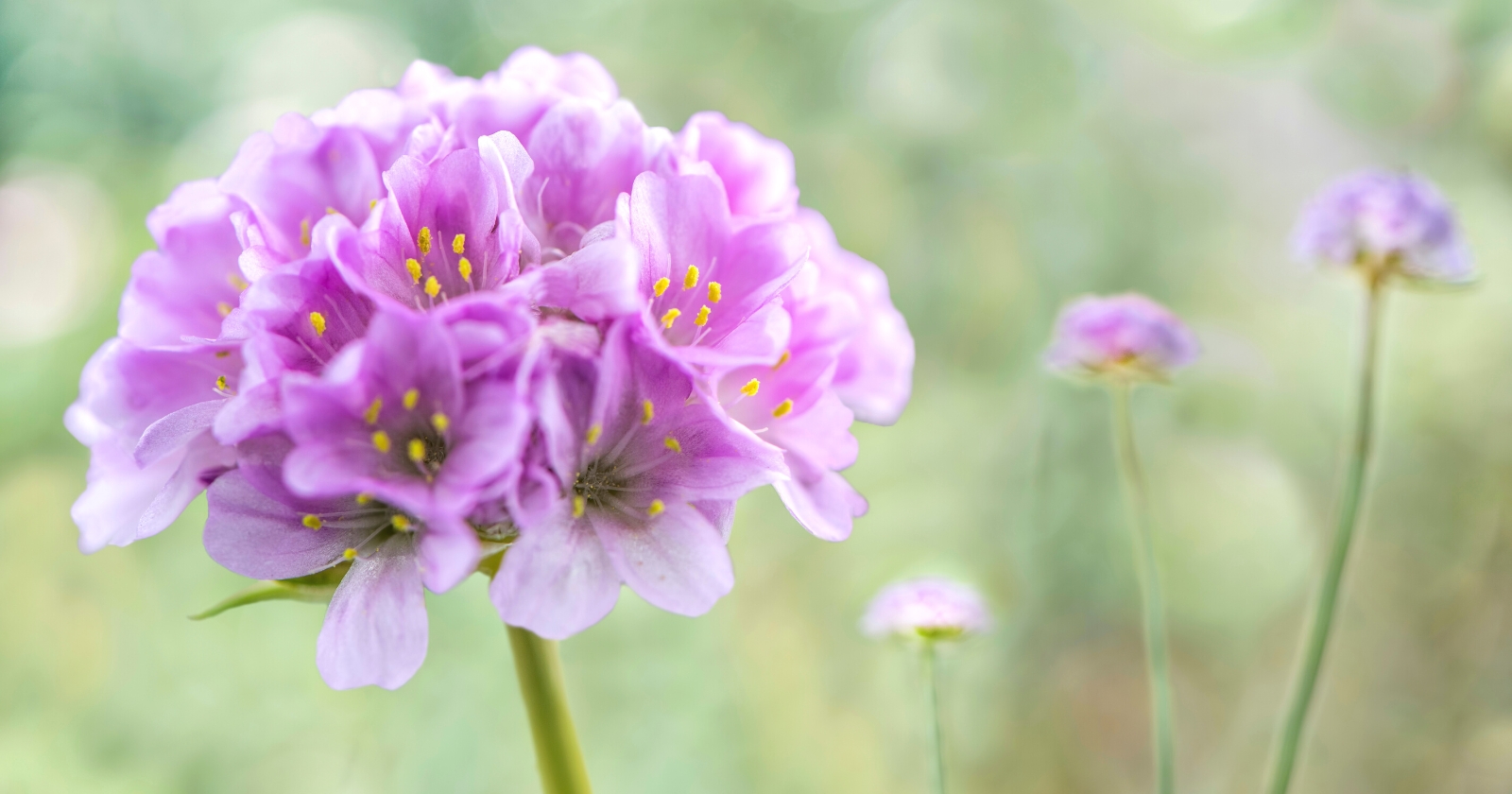
Leave a comment